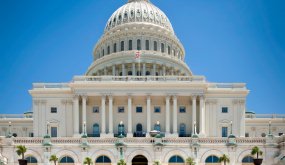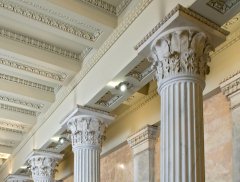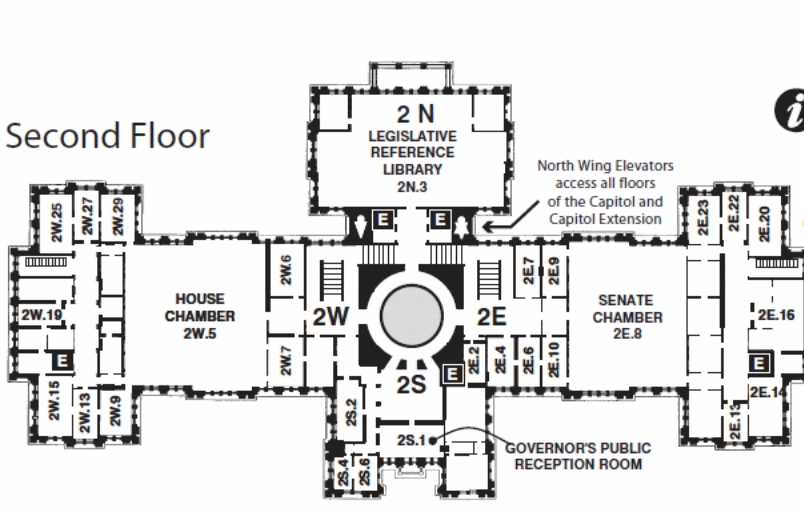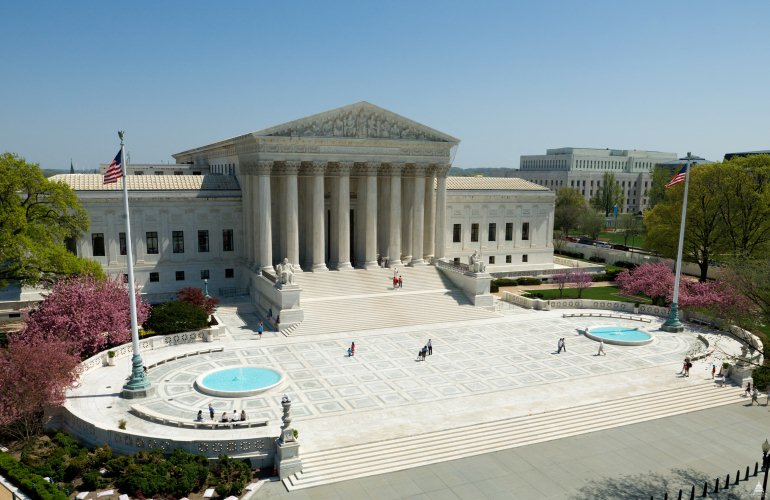Introduction
According to Construction History (n.d), the Capitol Building was designed and erected under the commissioning of President George Washington in 1793 under the architectural directions of George Hadfield, Stephen H. Halle, and James Hoban. Construction work progressed under the supervision and direction of Benjamin Henry Latrobe, who introduced different modifications to the design of the building as construction progressed to clarify and simplify construction work (Misek, 2002). The first phase of construction work which progressed under the supervision of Henry Latrobeled to the completion of the southern and eastern wings in 1811. The construction of the northern wing which started in 1808 was completed in 1813 under the same supervisor to accommodate important government offices. Progressive modifications, restoration, and construction in later years of the building were done by Charles Bulfinch in 1818 (Zissman, 2003). Critical modifications included changing the copper covered dome to suit the architectural requirements of the building as shown in figure 1 below.

In 1962, as construction work progressed, new modifications including the introduction of the Eastern Front to accommodate the sandstone structures which were buttressed by the additions. At the same time, the senate subway steps were constructed, bird proofing was done, and the lighting system was done and improved throughout the building.
In 1983, renovations and the strengthening of the building were done, with critical attention paid to solve the structural problems that were caused by the defects in the original design of the building (Construction History, n.d). A detailed review of the architects involved in the design and construction of the Capitol Building shows the contributions they made and the approach they used to design and construct the building as shown in figure 2 below (Misek, 2002).

Typically, the central portion of the Capitol Building is composed of monumental stairs, a dome flanked with three abbrevaition wings, and eight tritite windows with the internal of the dome made of five inches steel works. The interior lighting is provided by elaborate lighting systems and other architectural finishes integrated into the system uisng differen desing materails.
The architects
According to Construction History (n.d), the fundamental sketch of the Capitol Building was made by William Thornton based on the Greek, the Athens, and the neo classical Greco-Roman architecture depending on the principle of balance, and the presence of columns to adopt the complex modern purpose. The design was developed by a self-taught architect of the Irish American origin known as James Hoban, in 1792. James Hoban designed Capitol Building to reflect the President’s palace and the cultural values of the people of America under the supervision of George Washington. The design by William Thornton consisted of the Washington mall envisioned by Pierre Charles L’Enfant, who initially designed the mall that was lined with significant cultural buildings, which was later supervised by the commission of fine arts under the leadership of Burnham, McKim, Olmsted, and St. Gaudens (Zissman, 2003).
Carl Buehner of the Salt Lake City worked on the walking forms at a cost of $ 8,400.80 and used reinforced concrete made of Portland cement, sand, water, and medium open hearth steel, and in accordance with the specifications outlined in the standards for the manufacturer’s engineering materials. The architect of the Capitol Building was made to accommodate different and reveal the values of the people of America and is distinctly defined by the use of columns and materials (Zissman, 2003).

Columns were used throughout the capital building and reflect the democracy of the United States and the neoclassical looks, and, are classified into the Corinthian, ionic, and Doris columns. Investigations reveal that “the Corinthian columns are distinguished by elaborate cornice” (Zissman, 2003), and a “bell shaped capitol with volutes, and two rows of acanthus leave” (Zissman, 2003). The Corinthian columns are mostly found outside and inside of the Capitol Building, the library of congress, the Supreme Court building, and in the Russell senate Office building (Zissman, 2003).
A close study of the building shows that “the outside of the building is made of modified Corinthian columns” (Capitol facts & history, n.d). In addition, the first “floor of the Capitol’s House wing is made of marble columns line the corridor” (Capitol facts & history, n.d). Other sections of the building are made of the coffered domes with the oculus wood used to make the rotunda through which the natural light flows (Capitol facts & history, n.d).
The design
Capitol Hill is accessed through the E1 and E2 floors and has elevators that enable users to connect and get access to other areas in the building (Capitol facts & history, n.d). Other access points include the north wing elevators, as shown in diagram three below.

Materials
The materials used in the construction of the Capitol Buildings were selected to reflect the element of sustainability and to give the building its structural strength. The materials used included sandstone, iron, marble, and Cast Iron. One of the materials that contributed significantly to the aesthetical values ingrained on the columns was marble (Capitol facts & history, n.d).
Marble
To achieve the structural and aesthetical benefits of using marble, marbles was used to make the columns of the Capitol Building. However, the disadvantage with marble is that it remains porous and when exposed to the skin oils, it gets easily destroyed (Capitol facts & history, n.d).
During the construction of the Capitol Building, marble was quarried from the upper Potomac River and sometimes imported from Italy and other states within the United States which were major suppliers. Massachusetts was the most extensive source of marble in the United States (Capitol facts & history, n.d).
Cast Iron
Cast iron is a material that has been in use for many centuries to make different structures. Cast iron was used to make structural elements, plumbing and gas lines, plates, columns, and cast iron girders. Cast iron was used to make library extensions and railings on the ground. Typically, “cast iron is an alloy of carbon, iron, and silicon mixed together in proportions depending on the application of the resulting material” (Richard, 1980). During the construction of the “Capitol Building, the engineer Montgomery C. Meigs extensively used cast iron to make the roofing of the building” (Richard, 1980). Sandstone was another material of significant value.
Sandstone
Sandstone was critical in the construction of the Capitol Building because it was easily available and could be sourced locally. Sandstone formed the recipe for basic concrete and could be used to make some structures as required in the construction of the building. The source of sand for the construction of the Capitol Building was from the Aquia Creek, Virginia. Sandstone from the quary was used for the construction of columns, walls, floors, and extension classing. However, architects discovered that the use of marble could replace sandstone as a building material. That is because; sandstone is vulnerable to erosion and wear. Sandstone was widely used in the construction of the Capitol Building because it was easy to access and easy to quary.
Power for sustainability
Different heating plants were constructed to provide power for lighting heating. The building was designed to be energy efficient based on current sustainable strategies of water harvesting, usage, and external cooling and direct heating systems.
Design for Sustainability
A comprehensive investigation into the sustainability of the Capitol Building shows the facts which the architects considered to ensure the building was sustainable. Kletting read the details of the design 4 to 6 weeks in advance to optimize site orientation and make alterations where necessary (Architect of the Capitol, 2005).. Typically, the concept was “to design as you build” to allow for general variations in the original specifications and reduce costs, improve the architectural appearance, and make the building durable (Zissman 2003),

According to Richard (1980), the Capitol Building, like other historic structures was designed for sustainability, based on the use of preservatives for building materials. The contractors used preservative materials to provide wood and other building materials the required mechanical and chemical properties required for the material to last long. Creosote which is a black or brownish material was used to make wood resistant to insect attacks. However, new improvements and discoveries led to the use of other materials because Creosote was known to be flammable, could not be painted and was carcinogenic, which required the substance to be used with caution. Wood was preserved through technique known as “wood soaking’, hot and cold soaking, spraying, and steam and cold quenching. However, changes were constantly introduced to accommodate changing needs and new discoveries.
The changes of the design frequently introduced during the construction were to substitute new materials and eliminate some unsuitable materials and elements. A typical example was the substitution of terrazzo for stone for use in the third floor and in the corridors of the ground level, the public places, art galleries, the libraries, and the main entrances with stone. The aesthetical values were evidently integrated with the use of Georgian marble, which was installed at the border on the main floor. According to a study by Zissman (2003) sustainable features of a building, which can respond to the climate changes and the site, should be considered to ensure that the history of the building is preserved. A fireproof material, as contained in the “Second Supplement Appropriations Act 1995” was used to protect the building from destruction from fire (Rhode Island Fire Safety Code, n.d).
Another critical element of the design was structural steel which was properly tested at the Pittsburgh Laboratory to insure compliance with the building codes. Portland cement was used with clean sand and was made free from any impurities of wood, acids, straw, and oils (Building Codes for Energy Efficiency, n.d). The design and construction was made sustainable because of the use of exterior materials that addressed the need for the classical experience and design. To maintain the structural strength of the concrete and ensure that cement, water, and sand were combined in the correct proportions at temperatures below the 28 0C mark, the cement was heated to raise the temperature to the required level to ensure the structural stability of the resulting concrete was achieved (Rhode Island Fire Safety Code, n.d).
The typical elements characteristics of the Capitol Building included the ability to provide improved indoor air quality, efficient mechanical systems to provide water heating systems and waste disposal and other services. In addition, the highly efficient mechanical elements were made integral to the building to reduce annual energy usage and unnecessary energy consumption. Typical components included heating systems which incorporated thermostat diaphragms, compressors, reservoirs, dampers, and meters for effective heating (Architect of the Capitol, 2005)
The use of adequate and proved materials testing and maintenance standards to provide the required and compliant structural strengths for the building was done in accordance with building standards (Construction History, n.d),
Control systems were implemented during the design and development process, controlling and optimizing procedures were put in place to ensure sustainability, routing, and preventive schedules were made integral to the maintenance of the building to meet safety, reliance, and reliability goals. Architects of the Capitol Building had to consider factors such as privacy, space, and flexibility (Richard, 1980). This is largely because the building needs to accommodate the increasing duties and responsibilities of the future. As evidenced by Capitol Building, the building has experienced immense transformation from its original state to what it is today.
Costs
The potential for cost savings during the construction of Capitol Building resulted from a clearly defined communication structure between the construction engineers, the designer, and the team members working on the project. The project managers ensured the costs were kept to a minimum through competitive bidding. Typically, the engineers awarded the work at different stages in the construction process were able to estimate the costs of the awarded jobs with reasonable accuracy (Richard, 1980). A typical example include the estimates of the which provided for the legislative building. In this case, the “impressive structure comprised of more than 173 million pounds of stone, steel, concrete, and bricks combined together” (Zissman, 2003).
According to a study by Richard (1980), less expensive carpeting was done for the floors in the Supreme Court chambers, and the Senate using an earlier form of concrete known as “asbesticite”. This implies that the project costs of constructions, as well as the latest designs and ideas of that time, were assembled to make the best of the construction out of the project. Cost was put as low as possible without compromising the quality of the resulting building. Concrete was placed, compacted, and transported with adequate care to avoid segregation, and allow the mix to flow and eventually mixed suing mechanical vibrators (Richard, 1980).
To ensure costs were kept to a minimum, contractor Stewart submitted different samples of terra cotta designs for the construction of the Capitol’s ornamental work. Contractor Stewart’s work consisted of the use of a cementitious material known as plaster cement to reduce the cost of alternative materials. The cement plaster was used in the interior to make classical decorative elements and several alterations and options were made to make a cost effective structure to promote better health, appearance, and improved aesthetical values (Richard, 1980).
To realize the economic benefits of a sustainable design, competitive bidding was done, and the lowest bidders, James Stewart & Company were offered the contract to construct the Capitol Building. Several modifications were made on the original materials to adopt and use new materials for cost effectiveness and sustainability. Material upgrades were made to use key resources including water, land, and energy more efficiently and to use newly discovered materials with overall lower lifecycle costs, leading to a high performance sustainable building.
Some of the benefits realised from the use of the sustainable building approach included longer building life time, lower risks, lower project costs, and increased asset value. The design for sustained costs was done at the conceptual stage of the building, leading to lower first costs. The design was made space efficient, but adequate to meet the objectives of cost reduction of first costs. That was in addition to the elimination of structural over design based on the concept of “to design as you build”. The designer and construction engineer was able to use construction site waste management approaches to ensure some locations were preserved as waste disposal sites and costs were kept to a minimum (Richard, 1980).
Property Description
Selected and approved by President George Washington in 1793, Capitol Building architecture is one of the most impressive and symbolical buildings in the world (Zissman, 2003). Today, “the building covers an area of about 175,170 feet” (Architect of the Capitol, 2005). The height of the building from the basement is about 288 feet, and stretches at a length of about 751 feet, and 4inches. Its greatest width is estimated to be about 350 feet and the building has 540 rooms, which open to about 658 windows and 850 doorways (Architect of the Capitol, 2005). The building has been divided into five different levels, with every floor representing a different operation or capacity of the building. The ground floor consists of committee rooms and areas including the “Hall of columns, the old Supreme Court chamber, the Crypt under the Rotunda, and the Brumidi corridors” (Architect of the Capitol, 2005).
The Southern and the Northern wings of the building house the House of representatives and the senate. Major public areas of the building are also housed in the second floor. Under the dome, “at the center of the floor, is the Rotunda, which also serves as a gallery with paintings of influential people in the country’s history” (Architect of the Capitol, 2005).
Conclusion
In conclusion, the motivation for this study was to discover the history of Capitol Building, the architects who designed and constructed the building, the elements integrated into the design to ensure sustainability, the cost effectiveness approach used in the construction, and the approach the architects used to make the different wings and sections of the building. The study has established the significance of the building to the people of the United States. The study has shown clearly the structural requirements of the building, the techniques used to make a sustainable building, and the elements which can be used to make modern buildings sustainable.
References
Architect of the Capitol: Explore Capitol Building. (2005). Web
Building Codes for Energy Efficiency, (n.d), Web.
Capitol facts & history. (n.d). Web.
Construction History. (n.d), Web.
Richard, R. (1980). The Book of Buildings: A Panorama of Ancient, Medieval, Renaissance, and Modern Structures. Chicago: Rand McNally and Company
Rhode Island Fire Safety Code: Rules and Regulations Promulgated by the Board of Appeal and Review. (n.d). Web.
Misek, M. (2002). A “capitol” idea. Emedia Magazine, 15 (1), 22-23.
Zissman, M. (2003). Building team project of the year awards: Capitol success. Building Design & Construction, 44(5), 58-62.